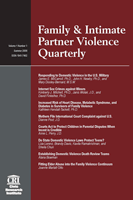The Dangers of Dangerousness Assessment
Author: Evan Stark.
Source: Volume 06, Number 02, Fall 2013 , pp.13-22(10)

< previous article |next article > |return to table of contents
Abstract:
Evan Stark is a sociologist and prolific author whose many years of studying and writing about the psychological and social dynamics underlying intimate partner abuse culminated in the publication of his 2007 masterpiece, Coercive Control. The book’s title reflects Dr. Stark’s central notion of coercive control as DV perpetrator’s internally-driven compulsion to control not just his victim’s behavior but her thinking and feeling, as well; he wants to dominate her mind, body, and soul. Due to a large extent to Dr. Stark’s scholarship, the term coercive control has become a part of the lexicon of researchers and practitioners in the field of interpersonal violence. With this body of work as backdrop, here Evan Stark casts a critical eye to the widely accepted procedure called Dangerousness Assessment, which some have hailed as a life saver for battered women whose male partner is potentially homicidal. He discusses the rationales for using the methodology, which may be of critical value in some cases but, according to Dr. Stark, misses the bigger picture as far as the kinds of abuse most victims suffer on a daily basis. He goes on to demonstrate how the lion’s share of this kind of non-lethal but exceedingly harmful violence is generally driven by coercive control.Keywords: Abuse-related fatalities; predictive value; coercive control
Affiliations:
1: Rutgers University (Emeritus).